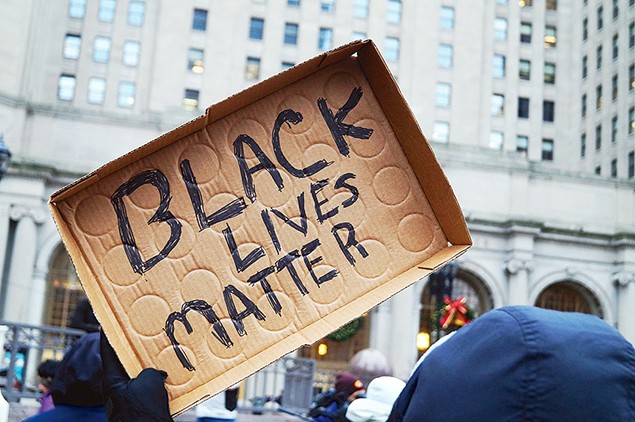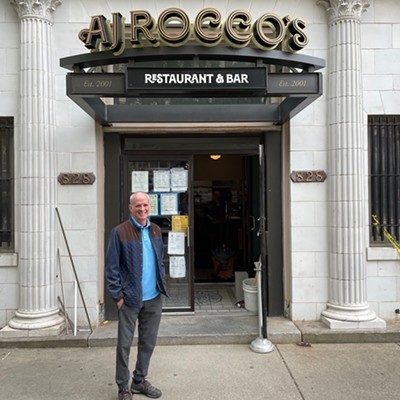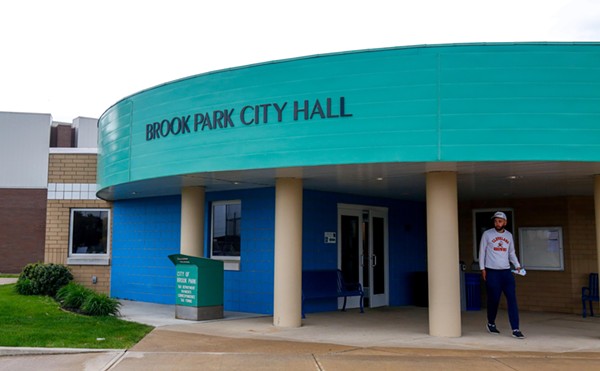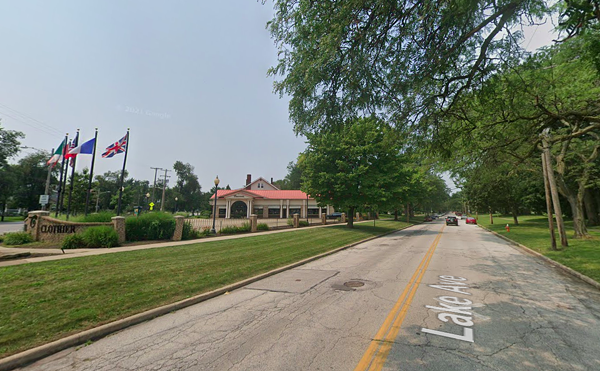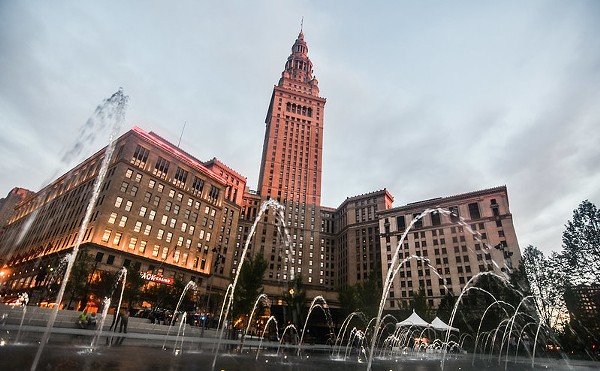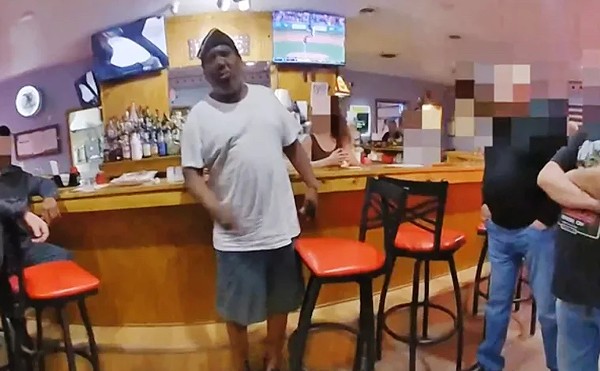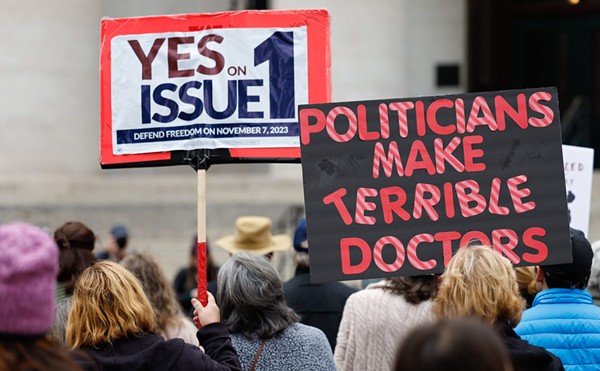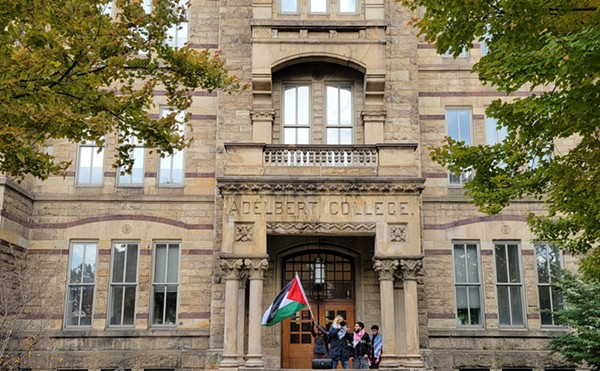Let’s dive right in, shall we, to the Regional Transit Authority (RTA) board meeting Tuesday morning at which city councilman Zack Reed took to the podium to decry the pepper spray incident of Sunday afternoon. Unlike his council colleague Jeff Johnson, who laid into RTA CEO Joe Calabrese Sunday night for commending transit officers on their “poise,” and who forcefully Tweeted that he considered the police action “UNACCEPTABLE,” Reed instead returned to the rhetoric of the pre-Brelo days, warning of “outside agitators” and riotous ne’er-do-wells from parts unknown whose “sole purpose is to cause chaos.”
As testimony, Reed provided two examples. He said on Friday, he received word from a credible source that members of the national Movement for Black Lives had instructed local conference organizers to advise Cleveland State University police that they wanted no white officers as security guards during the weekend’s Convening (M4BL). That demand has not been corroborated by CSU marketing staff, toward whom the CSU police shepherd all media inquiries, but Reed said he fact-checked it personally and believes it to be true. More on why this makes sense in a moment.
Secondly, Reed cited the treatment of NEOMG reporter Brandon Blackwell, who attempted to live-stream a gathering of activists in the immediate wake of the pepper spray incident outside CSU’s Student Center on Euclid Ave. Blackwell was asked to leave that gathering’s inner circle — It was for those of African descent only, one man announced — and was then unable to record from a distance when a handful of headstrong activists blocked Blackwell’s Periscoping mobile device with various articles of clothing and conference signage.
“Don’t touch my shit,” Blackwell can be heard saying near the end of the 20-minute video, when one young man (the outspoken organizer Courtney Drain) stuck his hand directly in front of the camera’s lens.
“I’ve got 800 black people behind me,” Drain responded. “What the fuck are you gonna do?”
Reed interpreted the confrontation as a dark clue about the anarchic designs of these outside agitators, who in this instance can at least semi-accurately be classified as outsiders — folks from all over the country caravanned to Cleveland for the first-ever M4BL Convening — though they shouldn’t be considered any more inherently prone to agitation than visiting Royals’ fans.
Nonetheless, a large group of them (the M4BL folks) were compelled to respond to what they deemed the mistreatment of a 14-year-old at the hands of GCRTA police. Reed said the situation on Euclid Avenue looked like a nightmare. He said, after watching the extended video that RTA played Tuesday morning, what it sure looked like was that RTA’s finest didn’t have much of a plan, or for that matter much of a single g.d. idea, about how to deal with those disinclined to adhere to law and order, by which terms he included the new parade legislation passed as an emergency measure last week (though not with his vote).
“That,” said Reed, pointing to the screen where footage from RTA cameras had been played moments earlier, “that is not a plan.”
“We’ve got a plan,” rebutted Valerie McCall, RTA board member and Mayor Jackson’s Chief of Government and International Affairs. “We are all united as One Cleveland. Safety forces citywide have been meeting across the table. But that was not planned.”
The irony, of course, is that the whole point of plans is to have contingencies in place for the unexpected.
Suffice to say, Reed is extremely concerned. He said as much in an email to Calabrese Sunday night, suggesting that both the pepper-spraying itself and the events leading up to it were worrisome. He has warned that the distrust between the community and the police may be reaching a boiling point, (last weekend’s Luke Easter Park Unity Festival and CPD Chief Calvin Williams’ alleged “rock star” status notwithstanding).
“If we’re not careful,” Reed told Scene, “this is gonna blow up in our face.”
Speaking of our face, and things blowing up in it, let’s return to Brandon Blackwell’s tribulations in the field, on which Mark Naymik bestirred himself to devote one half of his Tuesday-morning column:
“Blackwell, while he didn't like it, knew the crowd was within its rights to block his camera's view,” Naymik wrote. “He also knew he was well within his rights to try to record the action. That's journalism. No different than recording how police handle protesters, which he has done. No different than demanding access to court hearings to ensure justice is administered fairly for all.”
If I may humbly disagree.
That — and here you’ll just have to imagine me pointing to the rightmost tab on my browser, in which Blackwell’s video has once again malfunctioned. I frankly can’t bear to refresh the page and sit through the insufferable Elk & Elk ad one more time, even sans audio, but what I’m gesturing at is the content of the video itself — that’s not journalism.
The first, and not at all trivial, point I’d submit is that Blackwell behaved like a petulant douchecanoe. The question of whether or not he was constitutionally permitted to record a gathering in a public space (and he most certainly was) became irrelevant, in my book, the moment one man politely asked him to turn off his recording device and have a conversation. You want our story? The man asked. We’ll give you our story. We’ll talk to you. We’d just rather not be filmed right now. Blackwell refused, opting instead to persevere in his attempts to live-stream a not-particularly-newsworthy moment in an otherwise newsworthy afternoon.
“This is becoming the story,” Blackwell informed those blocking his view. “And you don’t want that.”
No indeed. Although that’s precisely what it became. Naymik was more than happy to christen Blackwell a victim of the activists’ — this is rich — “intolerance and prejudice,” and Reed and others jumped on the bandwagon. Have a look at us fretting about it now at 2:45 in the morning! Who knows what Blackwell’s directives were. Certainly not me. But I’ve mentioned before that I have problems with the NEOMG’s iterative reporting method, and I may as well say that I have issues with the Periscoping thing too. Though do permit me to say that regardless of my issues, I’m still blown away by those crime reporters’ ability to show up; they’re as omnipresent and unrelenting as midges, and that’s 100-percent-sincerely worth commending.
My Periscoping beef: It broadcasts a moment; it doesn’t tell a story.
The advantageous flip side that Periscoping’s adherents and supporters have mentioned to me: The footage is unburnished, undoctored, naked. That’s vital these days when the police and the protesters tend to provide vastly different accounts of the same events. (More on that soon). Here’s what the camera captured, a Periscope video says. You take it from there.
But when Blackwell arrives with camera rolling, it sometimes puts people on edge. It can make people feel exploited or somehow caught. Were the reasons that activists said Blackwell couldn't film, (through which indexing you can actually hear Naymik scoff), inconsistent and not all that persuasive? Yeah. But Naymik didn't mention the most important reason of all, which is that they asked him to stop. The camera creates a barrier, obviously, but it also creates an impression: that all personal pronouncements to the contrary, Blackwell doesn't seem to care very much about these people’s stories.
His decision to keep filming was entirely his right, but I’d also submit that it represents a pretty severe misunderstanding of his professional obligations.
As a reporter, it’s sometimes profitable to cultivate adversarial, even combative, relationships with people in power. Riling up Senators or sports owners to keep them honest is a good thing. (Filming police, as Naymik says: That’s journalism!) Put the camera in their faces to let them know the public’s watching. Be a prick and ask an indelicate question to keep them accountable. Sure.
But these are black protesters, whose faces you might find in the dictionary next to “those not in power.” In this instance, what does digging in one’s heels accomplish? The answer, I’d argue, is actually a lot less than just “nothing.” Given that these M4BL folks all undoubtedly have powerful, dimensional stories to tell; and given that the public had better buckle up for a long and necessary conversation about race; and given that that conversation must play out, at least in part, in the media; we’re all worse off. These activists now not only distrust and dislike Brandon Blackwell; their wider distrust of the media is hardened and/or validated.
Part of the reason, in fact, why coverage was so limited of the M4BL Convening itself was because reporters basically attended by invitation only. (Be advised on that score: Accusations that local reporters didn’t bother to cover the conference until the sensational stuff on Sunday should be rescinded, even though I suspect most reporters didn’t attend out of apathy more than respect. But regardless, I’ve been told that the media containment was largely by design. It went right along with M4BL’s commitment to being a safe space for people of color. Even some of the most ardent local white organizers didn’t attend the weekend’s Convening for that reason. On M4BL’s registration page, the distinction was clear: “We respectfully request our allies support the convening by funding and encouraging Black organizers, activists, and leaders to attend,” i.e. not by coming themselves.
So Naymik, whose full-throated allegiance to the Northeast Ohio Media Group is such that he now can’t even distinguish himself from his employer, — when Scene editor Vince Grzegorek, frustrated by the tone of Tuesday’s column, asked him if he’d attended the weekend conference at all, Naymik responded: “Yes. NEOMG was there.” — his assertion that “there was noticeable diversity, not just of race, among the attendees” is pretty off-base. There wasn’t much diversity of race there at all. In fact, that was like the Convening’s central thrust: that this would be a space for black people to "heal, learn, and build authentic relationships." This was a not a big secret.
It also casts Reed’s assertion about the CSU police in a less apocalyptic light. That request, if true, was simply in keeping with the Convening’s encompassing imperative. Likewise the by-invitation-only media presence. The predominantly white, predominantly sycophantic regional press corps who hadn’t already devoted meaningful coverage to the Black Lives movement simply wasn’t wanted. This shouldn't be seen as hostility. It’s just that the general assumption — which good luck refuting — is that all the media will do, by laziness if not by accident, is misrepresent and misconstrue their narrative.
Which brings us back to Sunday afternoon. Scene received a press release from the Cleveland Communiy Activist Network (ClevelandCAN) which sought to provide the other side of the story in the pepper spray incident. Until now, all that’s been released is the GCRTA statement and the narrative of events as relayed by transit police at Tuesday morning’s board meeting.
The ClevelandCAN statement “which exists to refute and clarify the misinformation issued by the GCRTA,” was intended, said ClevelandCAN co-founder Mo Jackson, as a joint statement from local activists and community organizers. Here's an uninterrupted account:
Near 24th St. and Euclid Ave., but a significant distance from the GCRTA police cruiser where the minor was being held, a group of community organizers began asking the officers present for clear answers about the boy's detainment. In a display that lacked empathy, an officer, now identified as, Robert G. Schwab, pepper sprayed several people gathered to protest, including at least one minor.
Street action medics acted quickly and began administering first aid to those injured in the officer's unprovoked abuse of power and authority. Simultaneously, several other demonstrators, as directed by LGBTQ leaders within the movement, chanted, sang and effectively communicated instructions throughout the group. The organized collective determination of the demonstrators resulted in the boy's release into his mother's custody.
As noted in GCRTA’s official statement, the transit cruiser initially tried to drive through the group of demonstrators twice. However, the statement contained several inaccuracies regarding the minor’s arrest, including the unsubstantiated accusation that the boy was being detained for intoxication. The EMS on scene refuted that allegation, and following the attack, the boy was released into his mother’s care.
You can watch the viral pepper spray video here.
A few quick notes before I let you be: Press statements are of course narratives themselves, which word (narrative) presumes a narrator. So things likes “the organized collective determination of the demonstrators resulted in the boy’s release into his mother’s custody,” should be understood not as facts, but as interpretations of events, the point of view of the person(s) telling the story. Q.v. "A short time later the woman stopped struggling and appeared to go limp," -Police report on Tanisha Anderson’s death.
Comparing the RTA and ClevelandCAN statements side by side yields some striking revelations: both parties claim they were foremost concerned for the safety of the 14-year-old, for one, which I honestly believe to be the case. The RTA statement provides no further detail on the minor’s level of intoxication, but an officer did say Tuesday morning that the youth was found on the Health Line, “passed out” and “drooling” with a bottle of alcohol in a brown bag next to him.
And to clarify: no one was arrested. An RTA officer reported on Tuesday that the boy was detained and handcuffed for his own and for the officers’ safety.
ClevelandCAN: “A group of community organizers began asking the officers present for clear answers about the boy's detainment.”
RTA: “Within minutes, a large crowd had gathered, surrounding the bus shelter. For the safety of the juvenile, Transit Police moved him from the open shelter area to a police cruiser. The crowd then surrounded the car, with some individuals pounding on the car in an attempt to remove the juvenile from the car.”
The footage, in this case, actually does seem to exculpate the RTA officers in many ways — Calabrese wasn’t just grandstanding when he wrote in a memo that his officers showed poise. As Naymik averred, the pepper spray was a bad idea, but the officers couldn’t hand over the youth to the crowd, as the RTA statement said the activists requested.
“There was an overwhelming feeling that we just couldn't let the police take another vulnerable member of our community away,” said Mo Jackson, in the ClevelandCAN press release. “For the Cleveland residents present, I believe we were all protesting in the memory of Tamir Rice and Tanisha Anderson. That feeling strengthened our resolve to resist police violence and win.”
The resolve was indeed strong, but in this case some observers — like Reed — shouldn’t be blamed for thinking that the resolve appeared less like “resisting police violence” and more like “impeding standard police work.” Anyone who’s ridden the Health Line more than once knows that RTA police periodically hop aboard to do fare evasion checks. In my experience, the riders they boot off are almost always black male teenagers, which is another can of worms; but the detaining of the youth doesn’t strike me, on its face, as an act of police brutality.
The other thing, though, is that despite the pepper spraying and the unwanted national spotlight, the boy was released safely into his mother’s custody. Everyone's okay. RTA officers suspect that some of the activists called the boy’s mother and she arrived on scene. That’s great for more reasons than one.
And no one can say what might’ve happened if the M4BL crowd hadn’t made it their business to intervene. The youth probably would have been subject to standard RTA protocol. He probably would’ve been taken to the police station and then driven home to his mom. Probably.
But despite what some might see as aggression — and the crowd was indeed intimidating, if not exactly violent; it’s not like one or two reps met at the 50-yard-line to seek answers and exchange intel with RTA Sergeants — they were willing to risk pepper spraying and more for the certainty that the boy would be safely released.

